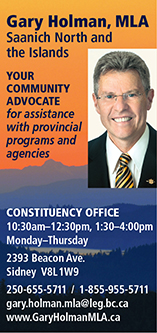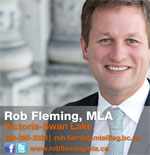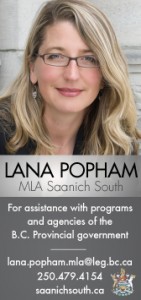Archive for February 2015

Provincial Democratic Reform
Community Meeting to be held in Brentwood Bay & Sidney
Gary Holman, MLA for Saanich North and the Islands will host two town halls on the Saanich Peninsula this month to discuss ways to make elections fairer and give citizens’ greater influence in how government operates.
The town halls are part of a public consultation process that Holman has undertaken in his role of Official Opposition Spokesperson for Democracy Reform. He’ll be travelling throughout the province meeting with the public and stakeholders to get feedback on the process and the type of proportional representation the province should use, should the BC NDP take government in 2017 and make changes to the province’s voting systems.
“The NDP will campaign for a YES vote and ensure the public gets all the information they need to make an informed decision,” said Holman from his community office in Sidney.
“Over the next year, my job is to consult with the public and stakeholders to get feedback on the process and the type of PR we should use.”
Wendy Bergerud, President of the Victoria local of Fair Vote Canada will be in attendance at the events. “We need a proportional voting system provincially as well as federally,” says Bergerud. She adds, “I am pleased to see that the BC NDP are taking a serious look at this and have now started public forums to discuss possible changes with citizens.”
Holman said that electoral reform is just part of a larger governance reform package the BC NDP will be putting forward in the upcoming spring session of the legislature. “Our intention is to both empower citizens and create greater accountability in the provincial government, an element that has been in decay for some years now,” says Holman.
The town halls will be held in Sidney at the Mary Winspear Centre, Activity Room 2 on February 3rd, and in Brentwood Bay at the Central Saanich Senior Citizens’ Centre on February 5th. Both events run from 6:30pm – 8:00pm, and will include representatives from Fair Vote Canada and Fair Voting BC.
www.GaryHolmanMLA.ca
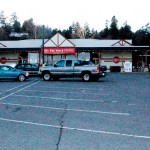
Cordova Bay Plaza – Strip Mall in a Time Warp
by Roger Stonebanks
Now that the 26-acre Trio property has sold for $6.1 million to Aragon Properties (a Vancouver land development company with ideas for a major residential project plus a commercial component) attention has turned to sometimes-forgotten Cordova Bay Plaza, just over two kilometres to the south.
The plaza is a 1960 strip mall that became trapped in a neighbour’s underground gasoline pollution problem. The public was well aware that there was a pollution problem at the nearby site of a Payless (owned by Shell Products Canada) gas station, which closed in 1997. According to the Cordova Bay’s newsletter, The Cordovan, Payless officials admitted at a general meeting of the Cordova Bay Association for Community Affairs on Jan. 21, 1998 that “the gas station site is contaminated and is now being remediated. Off-site contamination has not yet been tackled.”
It was in the summer of 1997 that the plaza informed tenants that it intended “very soon” to seek a Development Permit for a new shopping centre. In 1999 Saanich council, after public input, approved a new and much larger shopping centre as well as shops and 16 apartments in one three-storey building and a separate bank building. But council withheld issuance of the development permit pending two conditions being met: consolidation of the two lots that comprise the plaza property; and, importantly, confirmation from the Ministry of the Environment that no site remediation was required. There was no such confirmation. The plaza pollution saga was under way.
There were years of pollution remediation by Shell Products Canada as well as regular test
drilling nearby to monitor the spread of underground gasoline. A lawsuit and counter-suit in BC Supreme Court, started in 2003, and was settled out of court in 2010, with agreement that all details be kept confidential.
Scotiabank, which had intentions to build on the site, had to make do for a number of years in a double-wide trailer in the plaza parking lot, until it eventually moved into the south end of the mall.
Finally, on May 18, 2012, a Certificate of Compliance for the plaza property was issued by the BC Ministry of the Environment “regarding remediation of petroleum hydrocarbon and dissolved metal contamination” that migrated to the plaza from the Payless property at 5146 Cordova Bay Road. The certificate states that the plaza property has been “satisfactorily remediated to meet Contamination Sites Regulation Standards for commercial land soil use and marine aquatic water use and Hazardous Waste Regulation standards.”
But, the ministry cautioned that it made no representation or warranty as to the accuracy or completeness of the information received by the ministry on which the certificate was based. “This Certificate of Compliance should not be construed as an assurance that there are no hazards present on the site described above,” said the ministry.
Since then, no action has been taken by Your Family Food Mart Ltd., the plaza owner, to develop or sell the property. There are seven shops at the plaza, which is anchored by Tru-Value Foods. Currently, two shops are vacant.
Saanich Voice Online asked the plaza’s spokesperson, Brenda Ferguson, for an update.
“Most leases in the plaza run until Spring 2017 with Tru Value Foods being the largest tenant,” she said. “We have a vacancy in the old bakery [Euphorium Bakery] and since we have been trying to offer a lease that does not go beyond Spring 2017; it has proven very difficult to lease the vacant space.”
The plaza has “no immediate plans” for redevelopment given that the leases run until 2017 “but there has been lots of interest from buyers who would like to develop the site with no commitment from the owners to sell.” She added, “We seem to be in limbo. Now would certainly be a good time to think about redevelopment with the Trio site now sold.”
Whatever commercial-residential development plan for the plaza eventually goes ahead, it will have a significantly bigger building imprint on the property than the current strip mall. To give a sense of that change – the plan approved in 1999 was for 3,586 square metres of commercial floor space or 38,599 square feet. This was to include a supermarket three times bigger than the present 7,500 square foot grocery and extending west into open space behind the mall. Shops with apartments above them would be in a three-storey building on the south side of the property which now is green space. Scotiabank would be in a separate building in the northeast corner.
In the meantime, redevelopment is still “On Hold.” And despite the mall’s age, the plaza and its tenants have worked well to renovate and improve the appearance of the mall and grounds, including significant internal improvements to the supermarket when Tru Value Foods became the tenant in 2012.
Roger Stonebanks was a reporter for the Island’s daily when it was called the Victoria Daily Times and from 1980 the Victoria Times Colonist. He’s published two books and loves living in Cordova Bay with his wife, Helen.

The Greatest Conversation – but what’s it about?
by Roger Stonebanks
A new lobby group will hold a public meeting in February aimed at taking the municipal amalgamation issue to what it sees as the
next stage – a study.
Greater Victoria Conversation is the group and the meeting organizer is Susan Jones, the former president of Amalgamation Yes. The meeting will be held on Tuesday Feb. 24 at SJ Willis Education Centre, 923 Topaz Avenue, from 5:00 p.m. until 9:30 p.m.
The group says on its website that the meeting “is an event intended to provide an opportunity for Greater Victorians to come together and discuss what they want to see in the governance study to be carried out by the Province.” The group also said, “The study about governance and amalgamation will be underway in the near future.”
However, the BC government has not said (as of Saanich Voice Online’s deadline) that it will carry out a study of governance or amalgamation. Community Minister Coralee Oakes did say last November, after the variously-worded referendums, that “I remain committed to provide the support and resources required by the newly-elected local governments, once they have had an opportunity to discuss and review the results in greater detail.”
The GVC described its upcoming meeting as “an opportunity for the 60,000 (75 per cent of 80,000) who voted Yes to some form of regional governance study in the last municipal election to discuss the terms of reference that they’d like included in a study.”
Only two municipalities, North Saanich and Sidney, voted, specifically, for an amalgamation “study.” Central Saanich voted for something similar – a “cost/benefit analysis.” All three Saanich Peninsula municipalities voted to ask the provincial government to fund the “study” or “cost/benefit analysis” – but not for the province to do it. The next step will be the tri-municipal meeting on Feb. 11 at the North Saanich municipal hall. North Saanich Mayor Alice Finall said there will be an agenda item “regarding obtaining provincial financing for a municipally-conducted study.”
The word “study” did not appear on the successful amalgamation ballots in Langford, Esquimalt and Victoria – though Esquimalt did vote for “exploring” service sharing and reduction of municipalities. Oak Bay voted against amalgamation. Five municipalities
– View Royal, Colwood, Metchosin, Sooke and Highlands – did not vote on the amalgamation/governance subject.
Saanich voted for a “governance review” (avoiding the word “amalgamation”) – specifically, the ballot read “Do you support Council initiating a community-based review of the governance structure and policies within Saanich and our partnerships within the Region.” Council is awaiting a staff report before starting its review.
The GVC website identifies more than 30 supporters. Some of them were/are active in Amalgamation Yes which campaigned to have the question to be put on the ballot at the last municipal election. Amalgamation Yes, on its Home Page, encourages readers to join GVC.
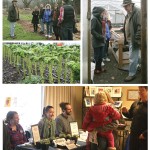
Banish Winter!
It’s time to plant
by Ed Johnson, photos by Ed Johnson
By the end of January when Saanich Voice Online hits the newsstands there will have already been four Seedy Saturdays on Vancouver Island, two of which were on the peninsula. The biggest one comes up on February 21st at the Convention Centre in Victoria. Seed collectors and growers converge in large numbers at these events to sell and trade the seeds they have grown.
Some may be businesses, like Mary Alice Johnson’s Full Circle Seeds, while others will be backyard gardeners with a bent for the unusual.
The first off the block was Saanich’s Haliburton Farm’s Seedy Saturday on January 10th, complete with farm tours and an informational lecture. It is a good time to check out the farm as the tours are free, unlike the rest of the year when an $8.00 charge fills the need for infrastructure demands – even if rubber boots, heavy coats and maybe rain-gear are the order of the day.
After slogging through the fields with fellow Haliburton farmer, Dr. Peter Liddell, retired UVic professor, learning of the where- and why-fores of organic farming, and showing off their new cold storage building and wetland restoration, the ‘tourees’ retreated to the warmth of the house to hear Christina Nikolic of The Organic Pantry speak.
“Dirt, Chocolate Cheesecake and You – a closer look at our soil,” was the title of Nikolic’s talk.
If pastries and coffee weren’t tempting enough, there were several seed sellers as well as books, seedlings, garden necessities and even a few winter squash to fill your knapsack with.
And, if you really wanted to get your hands dirty, Dr. Liddell assured that, “There is an opportunity to join a volunteer work-party on the first Saturday of every month.” Haliburton, now in its fourteenth year even has a food box program, delivering seasonal fresh produce to the door of ‘Greater Saanich’ residents.
The history of the farm is rich. In 2001 it was saved from development by a group of concerned citizens and the District of Saanich, which purchased the land. The non-profit charitable organization, Haliburton Community Farm Society, as it is now known, is being developed as a community and educational certified organic farm.
For income, plots are leased to farmers, memberships in the Society are sold, but the majority of their income is derived from grants. The farmers themselves are able to earn an income through the box program, farmer’s market sales, and direct sales to restaurants.
www.haliburtonfarm.org.
The next seed event attended by this reporter is technically not a Seedy Saturday because it falls on a Sunday – always has (the last three times), and always will, says the Gorge Tillicum Urban Farmers (GTUF). GTUF distinguishes itself in another ways as well. For example, their Seedy Sunday event is for members and those on a ‘friends’ list; the members donate their excess seeds in a sharing event; and all transactions are free.
The ‘give-what-you-have-more-of- and-take-what-you-need’ yearly event brings out 30-40 members from the 120+ household membership.
A loose-knit organization with no hierarchy, the group came about in 2008 because of shared concerns about food security in the neighbourhood. Members have since established a Community Seed Bank, lobbied for a bylaw change allowing chickens to be kept in Saanich, and created a very helpful ‘Critter Encounters’ and Weed Identification section on their website, www.gtuf.ca.
Julie Graham, speaking from the membership table, is enthusiastic to say the least. “Because my neighbour has an excellent compost system, I take my compostables around the corner to his place, and then when I need finished compost in the spring, it is available. We are a small community of like minds and like to keep it that way, that is why our membership is restricted to those who live and work in the area.”
Gabe Epstein, one of the founders, describes the group as more “conversational than presentational” in their meeting format.
“Acting as individuals rather than members some of us may be found in other gardening projects in the area, such as the Gorge Park Community Garden or donating food to Saanich Neighbourhood Place.”
This makes for a relaxed atmosphere, there are no AGMs, no elections, and no expectations placed on anyone, he adds. A coordinating group, open to all, decides on meeting dates and other activities as the need arises.
Watch for upcoming videos of a few members of this group on the Saanich Voice Online Youtube channel.
Accompanying this article online is a short video of Bill Morgan demonstrating planting onions from seed. Bill is a top contender for the largest onion in the Saanich Fall Fair, so he must know what he’s doing!
Ed Johnson lives and writes on his hobby farm in the Mt Newton Valley. His latest life goal is to one day grow enough asparagus to feed he and Lynne year-round.

Saanich, under investigation for spying?
Spyware story beginning to take shape.
January 20, 2015, the BC Privacy Commissioner, Elizabeth Denham, announced that she is launching an investigation into whether the District of Saanich’s use of employee monitoring software complies with the Freedom of Information and Protection of Privacy Act.
The events that preceded that announcement have been both interesting and confusing.
The story began in December when newly-elected Saanich Mayor Richard Atwell discovered that employee monitoring software had been placed on his new Saanich office computer, although, he at that time, chose not to involve the public in the matter. It wasn’t until January 12, 2015, that the mayor called a news conference where he made several stunning allegations involving both the Saanich administration and police.
The Mayor read a prepared statement alleging that someone in the Saanich administration, without his knowledge or consent, was planning to spy on everything that he did on his computer using a program called Spector 360. The mayor went on to say that he had been informed by legal counsel that these actions may amount to the criminal interception of private communications under the Criminal Code of Canada.
Atwell said that his legal counsel “wrote to Saanich Police Chief Bob Downie asking him to request an external police entity to investigate the allegations as we believe oversight of the investigation places Saanich Police in a clear conflict of interest.” The Saanich Police would have been investigating their own employer, the District of Saanich, including the wife of the police chief, who works as an administration assistant in the chief administrative officer (CAO) and mayor’s office.
Spector 360 Employee Monitoring Software is made by American software company, Spectorsoft. According to the company’s website the software is meant to detect and detail harmful employee computer activity. It “reviews individual and aggregate employee actions, as if you were sitting there with video-style screen playback.”
Spectrosoft says that their software is capable of capturing all user activity including website activity, personal web-mail, instant messaging, social media activity and private messages, file transfers, all keystrokes typed including passwords and banking information, and is completely undetectable by the employee.
Saanich council confirmed the use of Spector 360 on Tuesday, January 13, when they responded to Atwell’s allegations with a media release of their own titled, “Software Installed to Protect Integrity of Saanich Computer System.” The release explained that the installation was in response to recommendations made some six months earlier in a May, 2014 independent external audit of the District of Saanich computer systems. The audit apparently recommended the installation of security software, and as a result Spector 360 was purchased on Nov. 21 and installed on an initial group of key computers, including the mayor’s office computer, the following month.
The council’s release also stated that a review of the Saanich administration staff ‘s actions had been initiated by the district’s own police force and that, “they determined that there was no basis for recommending charges against Saanich employees.”
The following day the District of Saanich released a Backgrounder document to be used by staff to help answer media questions. It names Wordsworth & Associates as the firm that conducted the audit but it does not say that the security firm specifically recommended Spector 360. The document said that the mayor was given a Network Access Terms and Condition form at the time that his new computer was installed, although they have not received a signed form back from him.
The Backgrounder also states that in the interest of protecting municipal and public information, no additional details related to Saanich’s security measures or audit would be released. Saanich’s Network Access Terms and Condition form is attached to the end of the document.
It seems that the Office of BC’s Privacy Commissioner didn’t find Saanich’s monitoring of the new mayor’s communications quite so benign. The Office issued a news release on January 13th (and an update on January 14th), outlining privacy law around the overt and covert use of employee monitoring software. The release stated that, “…in the case of covert use of software there have been no cases brought before this Office where covert monitoring was found to be justified under privacy law.”
Six days later the Commissioner decided to ‘act on her own motion’ and take a step further initiating an investigation into whether the District of Saanich’s use of employee monitoring software complies with the Freedom of Information and Protection of Privacy Act.
“We need the facts concerning implementation of the software, including what methods of data capture have been enabled and the extent to which personal information is being collected from employees,” said Denham. The investigation is expected to be complete before the end of March and will be released to the public.
The days following the Commissioner’s announcement saw the media (finally) jump to attention. The Times Colonist’s (TC) January 23rd headline read “‘Spyware’ on Saanich mayor’s computer rare in B.C.’s large local governments.” TC reporter Cindy Harnett surveyed 25 of BC’s largest municipalities and found that not one uses surveillance software that can covertly capture keystrokes and screen images. She went on to report that BC’s provincial government also said it does not use software that covertly monitors workers, and the Capital Regional District says that they have only used it as a tool where employee conduct was being questioned, but currently does not have it on anyone’s computer.
The Globe & Mail, in its article, “Tracking software installed on Saanich mayor’s computer ‘atypical’,” spoke with Steven Schnider, principal consultant at Vancouver-based Procyon Security Group. He remarked that the security software on Atwell’s computer belongs in “hacker territory.” “It’s usually used by the black hat, not the white-hat security people,” he said.
The Vancouver Province’s Michael Smyth, in his column, “Embattled Saanich mayor could have the last laugh,” quotes Victoria political consultant, Mike Geoghegan, who worked on Atwell’s campaign. Geoghegan brought the story back to December when three Saanich insiders allegedly alerted the new mayor that spyware had been installed on his municipal hall computer. Apparently Atwell questioned the three insiders, tape-recorded their testimony and turned their statements into sworn affidavits now in the hands of his lawyer. Geoghegan said that he listened to the recordings, and is calling for a full investigation.
The media response to the issue has by-and-large been to call the allegations explosive, bombshell, and to describe Atwell as paranoid. But 12 days into the story and it’s now starting to look as though the narrative is shifting; apparently it may be the municipality that’s paranoid and not the district’s new mayor.
The mainstream media’s curiosity is finally beginning to pique. And there’s still plenty to be curious about.
Questions: Who is authorized to spy on whom? Where did the now-let-go Saanich CAO believe that his authority came from to carry out this monitoring? Who was he planning to report out to on his findings? Were his actions legal? Were they grounds for dismissal? Would enough rope have been a better choice than $480,000? If Saanich council is okay with the use of spyware in the workplace, then what other rights to privacy are they okay with weakening, and why?
For answers we look to the Privacy Commissioner’s report and the District of Saanich
Michele Murphy is a 30-year resident of Saanich, a bit of a political junky, has asked too many questions her entire life, and wishes SVO were a weekly.


